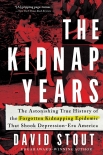The Kidnap Years:, David Stout [readict .txt] 📗

- Author: David Stout
Book online «The Kidnap Years:, David Stout [readict .txt] 📗». Author David Stout
There was also speculation that left-wing union members were behind the crime (the Weyerhaeuser company was having labor troubles at the time), but union leaders quickly dashed any such talk, expressing hopes for the child’s quick, safe recovery. “This is something in which differences of social position are erased,” Rowland Watson, Northwest representative of the American Federation of Labor, declared as he urged members to be on the lookout for the boy.173
By any standards, the kidnapping was a bold one. The name Weyerhaeuser carried as much clout in the Northwest as the Bremer name did in the Midwest and the name Urschel did in Oklahoma. And Washington State had passed a law making kidnapping punishable by death under some circumstances. Simple conspiracy to kidnap was a felony.
George listened to the voices; he thought he counted six, including that of a woman.
His captors had taken him to a house and blindfolded him, but not before he saw that the structure had two gables. He heard some of the men call one another by name: Harry, Bill, Allen. Or was it Alvin, as in Alvin Karpis, the bandit whose sneering face and piercing eyes were familiar throughout the country from wanted posters?
Sometimes, they took his blindfold off. When they did, they wore Halloween masks. George thought they looked funny, but he didn’t laugh.
And while homesick, he wasn’t terrified. He recalled what one of the men had said early on: “You’re worth more to us alive.” He knew he was.
Finally came the moment he had yearned for. One of the kidnappers approached him and said, not unkindly, “Kid, you’re going home.”
It was cold and wet, very early on the morning of Saturday, June 1, when three kidnappers put him in a car and drove. It was pitch-black, and while George didn’t know it, he was near Issaquah, a little city east of Seattle and northeast of Tacoma when the car stopped and he was let out. He was given two dirty blankets and a dollar bill, stuffed into a pocket.
“Your pa will pick you up,” a kidnapper said just before the car sped off.
But how will he find me? George wondered. Instead of waiting, he walked. And walked. It would be determined later that he walked some six miles in the cold and rain before coming to a farmhouse. He knocked on the door, and Louis Bonifas, a chicken rancher with ten children, opened the door.
“I’m the little boy who was kidnapped,” George said.
Bonifas’s wife, Willena, sat George down and gave him breakfast and dry socks and shoes. Then her husband put George into his Model T Ford and headed toward Tacoma. As daylight was breaking, he found a gas station, called the Tacoma police, and said he was taking the boy home.
Then a reporter insinuated himself into the events in a way that would be hard to conceive today. John Dreher, a veteran reporter for the Seattle Times, got wind that George had been freed and was on his way to Tacoma. So Dreher commandeered a taxi in the hope of intercepting the car bringing him home. Dreher figured there wouldn’t be many cars on the road so early on a Saturday morning, and he was right.
Dreher saw Bonifas’s car with a little boy inside, flagged the car down, and somehow convinced Bonifas to turn George over to him. Dreher either presented himself as a police officer or at least did not discourage the misperception that he was a cop. So on the way to the Weyerhaeuser home in the taxi, Dreher got an exclusive interview with the nine-year-old kidnap victim.
“Tacoma Boy Free, $200,000 Is Paid: He Names Karpis.”174
That was the lead headline in the New York Times of June 2, 1935. On the inside page where the article was continued, there were photographs of Karpis and Harry Campbell, who had escaped with Karpis in the Atlantic City shootout the previous January 20.
But did it really make sense that Karpis (perhaps accompanied by Campbell) had driven across the country to pull off what they surely knew would be another sensational kidnapping, one that would put hundreds of federal and local lawmen on their trail? Not really.
The car belonging to F. Rodman Titcomb, George’s uncle, was soon found abandoned in the Chinatown section of Seattle. Very quickly, money from the ransom began to turn up. A twenty-dollar bill turned up in Huntington, Oregon, where a train station agent recalled that a man had used the bill to buy a ticket to Salt Lake City. Another twenty turned up in Spokane, where it had been used to buy a postal money order. By June 7, a score of twenty-dollar bills from the ransom had turned up in Salt Lake City. So the FBI and local police were sure the kidnappers were from the region, not adventurous Easterners who had come west to strike gold.
At the FBI’s urging, Salt Lake City police stationed undercover officers in the cashier’s cages of downtown department stores. They didn’t have to wait long. On Saturday, June 8, a young woman appeared at the cashier’s cage with a five-dollar bill to pay for a twenty-cent purchase. The bill was identified at once as being from the ransom, and the woman was arrested. Another bill from the ransom was found in her purse.
Her name was Margaret Waley. She was just nineteen and had been living in Salt Lake City for only a few days. She was a newlywed. The police staked out her residence, and soon her new husband, Harmon Waley, twenty-four, showed up. He, too, had ransom bills on his





Comments (0)